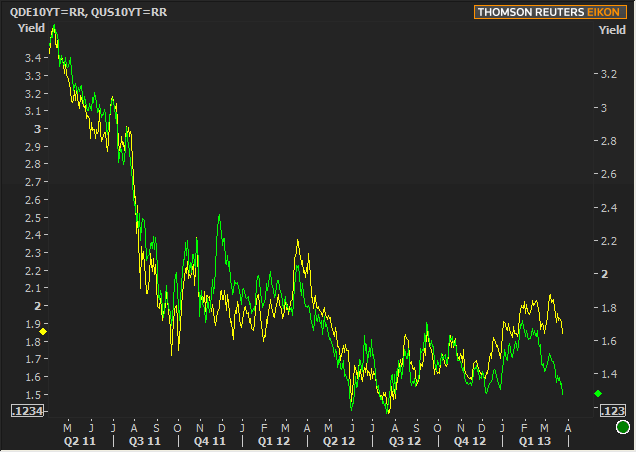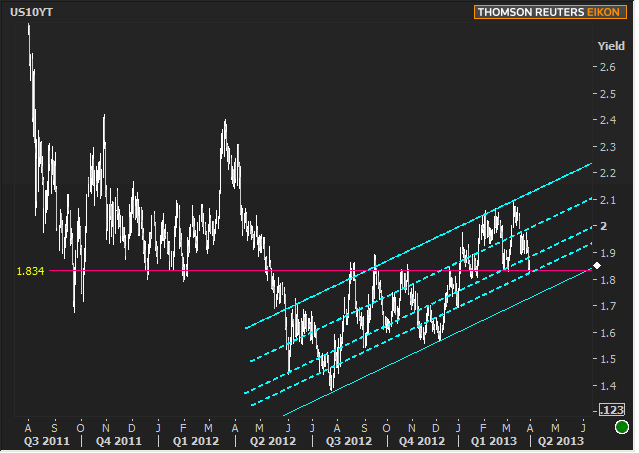With the failure to make any meaningful progress last week, the 2013 version of Italy's political crisis has come to a head. On the same day that US economic data showed meaningful improvements in consumer attitudes and spending, Italy's political leaders were out with long-awaited statements. But rather than indicate progress of any kind, Italy's President and representatives from all major parties were unified in their message: not only has there been no progress, but recent talks have created even more divisiveness. President Napolitano, who was credited with pulling Italy out of it's last politico-economic tailspin now characterizes efforts as "frozen between irreconcilable positions" (more from Reuters...).
This makes the prospects for any sort of functioning government increasingly dim and creates global economic risks that help counterbalance stronger economic data in the US. Those risks stem from the fact that a functioning government is needed in order for the ECB to keep buying Italian debt under the guidelines of its OMT (Outright Monetary Transactions). If the ECB truly stuck to it's guns in such a situation, the argument is that Italy spirals toward sovereign default, pulling the rest of the Eurozone down with it. Whether or not the ECB would stand by while such a thing transpired is another matter. There are compelling arguments as to why they wouldn't, but markets (particularly German Bunds) have assumed a defensive stance against the more negative possibilities.
Here's a chart of German Bunds vs US 10yr Treasuries. Note that Bunds (in green) have moved most of the way back down to their all-time lows while Treasury yields have done no such thing. This divergence partly reflects the gradual pricing out of the FOMC quantitative easing expectations and relatively stronger economic data in the US. Additionally, German debt will always be the most direct benificiary of Eurozone flights-to-safety in any situation where Germany is the most stable, big economy.

Because of the domestic economic component and the adjustment of FOMC expectations (not the divergence begins in earnest around December/January when the Fed Announcement and Minutes began shifting), we may simply be looking at a gap that doesn't have any urgent need to close itself for technical reasons. That said, the gap between the two interest rate benchmarks is stretched to levels not seen since the most acute realization of Eurozone crisis in 2010. That means US Treasury yields will still likely benefit to whatever extent the situation in the Eurozone deteriorates. From a technical standpoint, if German 10's break their current resistance floors in the mid 1.3's, so too might US 10's test a break below their mid to low 1.8's, proceeding toward a test of the longer term uptrend in rates near a boundary in the mid 1.7's.

The only economic data potent enough to cause further widening between Bunds and Treasuries is the big-ticket employment data seen this week. Manufacturing data earlier in the week is not insignificant but would offer only moderate course corrections at best. Despite Italy's repeated failures to make meaningful news, political headlines are still likely to be the biggest consideration on the first two days of the week. That dynamic shifts on Wednesday as the ADP Private Payrolls data marks a turn toward US Employment data as the center of attention. From that point on, any Italian news would have to be substantive in order to be seen and felt in domestic markets.
|
Week Of Mon, Apr 1 2013 - Fri, Apr 5 2013 |
|||||
|
Time |
Event |
Period |
Unit |
Forecast |
Prior |
|
Mon, Apr 1 |
|||||
|
08:58 |
Markit Manufacturing PMI |
Mar |
-- |
-- |
54.9 |
|
10:00 |
ISM Manufacturing PMI |
Mar |
-- |
54.2 |
54.2 |
|
10:00 |
Construction spending |
Feb |
% |
1.0 |
-2.1 |
|
Tue, Apr 2 |
|||||
|
09:45 |
ISM-New York index |
Mar |
-- |
-- |
572.7 |
|
10:00 |
Factory orders mm |
Feb |
% |
2.9 |
-2.0 |
|
Wed, Apr 3 |
|||||
|
07:00 |
Mortgage market index |
w/e |
-- |
-- |
823.7 |
|
08:15 |
ADP National Employment |
Mar |
k |
200 |
198 |
|
10:00 |
ISM N-Mfg Bus Act |
Mar |
-- |
56.8 |
56.9 |
|
10:00 |
ISM N-Mfg PMI |
Mar |
-- |
55.8 |
56.0 |
|
Thu, Apr 4 |
|||||
|
07:30 |
Challenger layoffs |
Mar |
k |
-- |
55.356 |
|
08:30 |
Initial Claims |
w/e |
k |
347 |
357 |
|
Fri, Apr 5 |
|||||
|
08:30 |
Non-farm payrolls |
Mar |
k |
200 |
236 |
|
08:30 |
Private Payrolls |
Mar |
k |
209 |
246 |
|
08:30 |
Unemployment rate mm |
Mar |
% |
7.7 |
7.7 |
|
08:30 |
International trade mm $ |
Feb |
bl |
-44.6 |
-44.5 |
|
15:00 |
Consumer credit |
Feb |
bl |
16.00 |
16.15 |
|
* mm: monthly | yy: annual | qq: quarterly | "w/e" in "period" column indicates a weekly report * Q1: First Quarter | Adv: Advance Release | Pre: Preliminary Release | Fin: Final Release * (n)SA: (non) Seasonally Adjusted * PMI: "Purchasing Managers Index" |
|||||





